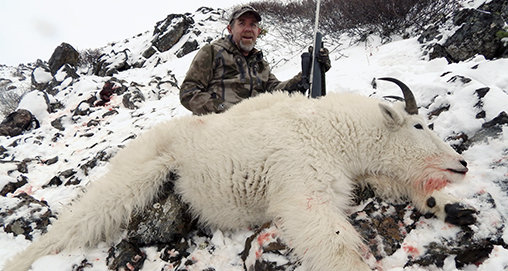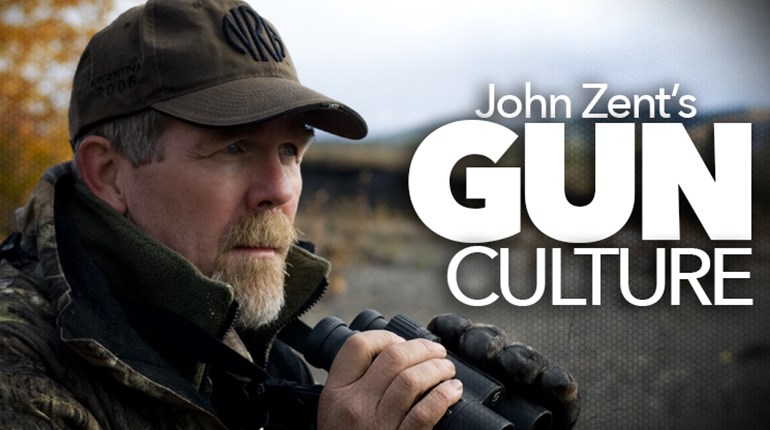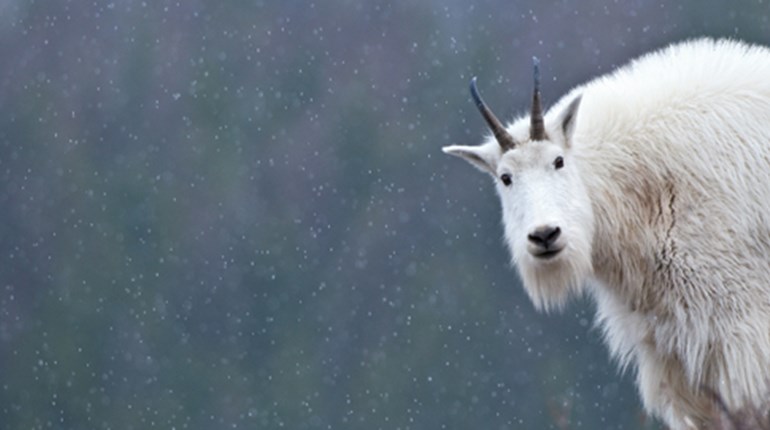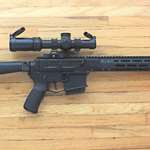
 Let’s just get the two-old-goats joke out of the way right now. It’s bound to come up anytime a graybeard like me talks about hunting the American mountain goat, so have your fun, and then we’ll get on to the nitty-gritty.
Let’s just get the two-old-goats joke out of the way right now. It’s bound to come up anytime a graybeard like me talks about hunting the American mountain goat, so have your fun, and then we’ll get on to the nitty-gritty.
Of course I concede that waiting until one’s 60s may not be the ideal scenario, but how about it’s better than not going at all? Just recently I read an account of a 78-year-old’s successful mountain goat hunt, and my outfitter and guide in British Columbia—Reg Collingwood and Jake Giguere, respectively—were telling me about a grandma who at age 70 tagged along on a recent hunt of theirs just for the fun of it. I will also confess to some serious self-doubt. Partly that was based on experiences hunting other mountain game, notably when goats were spotted in the process. Just getting to where the glassing occurred was always something of a trial in itself, and I was left wondering how the heck one was supposed to get up there onto the vertical terrain where their distant white forms glowed against the gray-brown rock. Those half-dozen sightings during elk, bear and sheep hunts essentially confirmed what seems to be prevailing wisdom, oft repeated in hunting tales, including a few cliffhangers here in American Hunter, that mountain goats live in the continent’s most treacherous places and thus are our most difficult native game.
There was just one fly in that soup. During a long-ago bighorn hunt in Colorado, while climbing the south face of Mount Princeton, I topped a ridge to find a band of 20-some goats grazing in a sheltered basin. Unfortunately no sheep were in tow, so I kept slogging toward the summit until gaining an even higher crest, the back side of which was dotted with more goats, curiously enough feeding alongside a bull elk and his cows. Still no sheep, however, so I trudged on until the ascending ridgeline narrowed and bladed into a snaky tightrope littered with golf-ball gravel and banana-peel skiffs of wet snow, a path where, just inches laterally, all swept perilously into nothing.
Vertigo—whoa! I hunkered down, straddling the ribbon of dirt that kept me from pitching into the blue yonder. As I clung tight, the spin cycle gradually eased. There was no going any farther, not me anyhow. I started reverse shinnying, careful to clamp down with both hands and both legs. Then reflex kicked in and, what the heck, I reached for my binoculars. And finally found some sheep. They were another 1,500 yards up near the top. But there was no going forward right there, and it was too late in the afternoon to work a detour. On the way back down I passed the two bands of goats.
I thought about that one as Reg and Jake debated which bunch of goats we would pursue the following morning. After a long jet boat ride upriver from the Collingwood Brothers’ historic Hyland Post lodge, we began spotting our white-coated quarry in late afternoon.That was especially good news for Reg, who had just finished a tough-luck hunt with a client he called “young guy” and “real go-getter.” Heavy overcast had grounded them in camp several days, and on the others, the men blind-climbed into jagged haunts strangely absent of goats. Defying normal odds, the go-getter’s tag never did get punched, a particularly ironic turn considering his superior fitness.
In fact the success rates of Collingwood hunts overall are very high, one reason for their remarkable longevity, now approaching 40 years in the outfitting business. While there are many reasons, you can in part attribute their success to the abundance of big game present where they operate in the heart of British Columbia’s Spatsizi Wilderness. In the mid-1900s, as game populations struggled to recover elsewhere, this is where traveling sportsmen found a paradise of Stone sheep, grizzly and black bears, moose, mountain caribou and goats. The old fur-trading station founded by the Hyland brothers transitioned to hosting hunters, and as one of three Collingwood base camps, Hyland Post still lives up to the legend. Within a few hours of camp, my partners and I have encountered trophy rams, bears, moose and caribou.
We had to travel a bit farther to find goats, but there they were, back on mountains where Reg has seen them for decades. Glassing right from the boat, my guides identified mature billies in both of the two bands we located, and studied their black, spiky horns, tackling the amazing feat of distinguishing the good 9-inch specimens from the real-good 10-inchers. And doing so from miles away.
No doubt Reg and Jake were also sizing up the client in the boat with them. No one would call him “young,” and the go-get remained to be seen. The outfitter, himself a 50-something north-country lifer, was leaning toward going after the second band because he was more convinced about its billies’ trophy potential. Jake, barely 30 but a seasoned mountain-man who had previously guided me to an outstanding grizzly, seemed to prefer the first group, which we could pursue directly from the spike camp where we’d spend the night.
The crux of it was what it would take to reach the places where the goats were feeding that afternoon. Jake’s band was spread across what appeared to be a series of perpendicular fingers, ravines and outcrops flanked by sparse patches of willow and sub-alpine fir. “Just hike up through the timber to the left,” he plotted, “get up top, boots on the skyline, and come over above them. At least two shooters in that bunch. We’ll find one of ’em. Bam!”
“Yeah, you could,” Reg countered, still glassing his goats, which, from our vantage looked like fat white flies clinging to a craggy tower God clearly did not intend for human passage. “You could do that over here, too.”
Oh? Normally I leave all where-to-go-tomorrow decisions to the pros, but since it seemed there was more at stake than the customary go/find/stalk/kill/pack-it-out sequence, I started to jump in.
Then Reg piped up, “Would you look at that, that billy pawing dirt on himself. He’s really going at it. He’s a big one, too.”
We took turns in the spotting scope, intrigued by the spectacle as the goat churned up grit with its powerful forelegs. “No wonder they call ’em ‘red goats’ around here,” I observed. In fact “Spatsizi” is the Tahltan Indian word for red goat, and accordingly the area has long been dubbed “Land of the Red Goat.” Spatsizi’s mountains tend to have lots of iron oxide at the surface, so prevalent that bare, eroded slides are often the color of a new brick. In the course of digging beds and rolling about in dust baths, the goats’ thick white fur takes on a reddish hue.
“They get even redder after you shoot,” said Reg. “That’s what we want.”
We returned to our two-tent, riverside spike camp without resolving where we were going in the morning, and the conversation over a dinner of chili, salad greens and toast with jam took a hundred interesting twists that addressed everything but the matter at hand. That evening I learned:
• Bobby Orr is the greatest hockey player ever. Gretzky? Not even close.
• Though it’s fun and lucrative to guide steelhead fishermen, it’s not nearly as satisfying as guiding hunters.
• As of fall 2012, Reg could still outrun a charging grizzly, but only long enough to lead it by his alert hunter, who shot it dead and saved his life.
There was much more and the good cheer kept us up late. “Guess we’ll go up there,” Reg stood and gestured to the slope behind camp. “You know … these goats … are way underrated as game,” he concluded and headed for his tent.
I knew enough to eat a big breakfast—eggs, bacon, leftover chili, potatoes, toast, coffee and water—ugh, but necessary. Methodically, each of us prepared for a long day and an early start up the mountain.
First Reg asked if I was ready, then a minute later Jake popped out of the tent and posed the same question. My pack, rifle, rainwear, water bottles, etc., were all right there, but they weren’t really asking if my gear was ready. “One step at a time,” I replied. At least I was ready for that.
At first there was a friendly trail bumping upward through old-growth timber. Then we crossed and re-crossed a creek, lost the trail, and abruptly hit a wall. The trees grew from it at acute angles and while they sometimes impeded progress, they also provided hand- and footholds. From there on our steps were decidely more vertical than horizontal.
We climbed that hill for the next three or four hours, Jake in the lead, Reg at the back, going steady, stopping for a minute now and again to catch our wind. Snack time is my only distinct memory. Throughout the trek, we were closed in by forest, toiling in earnest, leaning closely into the steep grade, and so it was tough to sense our progress.
Finally the timber thinned and we passed through a series of snowy clearings. A shed-sized boulder served as a waypoint where we stopped to ventilate and wipe sweat from our eyes. Jake pointed right, indicating our final ascent to the ridgeline that would take us to the stretch where we could start peeking over the edge, looking for goats.
I stumbled and came up looking left, and spotted a goat nearby. Though it was the first one I’d seen up close since those long-ago Colorado goats, I knew it was a billy. It had everything Reg and Jake coached me to look for—chin whiskers, massive front shoulders topped by a distinct hump, long hair that formed “chaps” on the front legs, horns that were twice as long as the space between them.
Jake and I eased prone, and while I tore the end caps off my scope and chambered a round, he glassed. “Wait, wait,” he repeated. “Wait.”
I didn’t know why we were waiting. The billy was solo, 225 yards away, standing where it couldn’t drop or roll very far. It was a perfect setup, meant to be.
I decided I was going to shoot regardless of how Jake judged its trophy status.
Finally, “Okay. Shoot.” But now the goat was walking straightaway, and then passed behind a clump of fir. So I had to wait some more.
But not for long until the billy cleared the bush, and then I hit him with a diagonal shot through the ribcage, lungs and off shoulder. He turned back toward us and I hit two more times before he fell. I was shooting a Federal Premium load with their new Trophy Copper bullet, in this case a 180-grain slug from my Kimber .300 WSM. It delivered a clean, ethical kill, but still … it had taken three hard, on-the-money hits to drop the tough old goat.
The guide and I lay still in the snow watching for movement until from behind Reg chirped, “I think you got him.”
The goat was more magnificent than I had expected. Though not real tall, he was imposingly solid and square. His dingy-white pelt was thicker than any deer, elk, sheep or bear hair I have handled and extravagantly long. The needle-like black horns, so modest compared to other trophy headgear, were menacing weapons nonetheless. Reg was right about mountain goats being underrated.
It started to snow as we photographed and dressed and quartered my kill, and for a time the air turned bitter cold. On the peak above we spotted a Stone sheep ewe with a lamb. Later we packed the meat and cape along an alternate route that took us above the secluded chute we originally intended to hunt. The band we’d spotted the previous afternoon was still there, including another big billy. We pulled out our cameras and talked about what might have been if luck hadn’t intervened.
More than once it has been my luck to find mountain goats downhill from wild sheep, and while I know that’s an anomaly, it’s also quite clear you can never really know what happens up there until you climb that mountain.


































